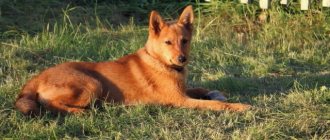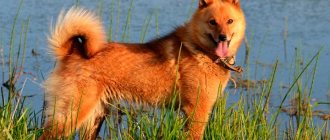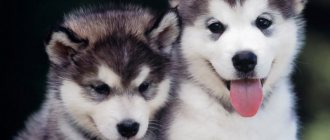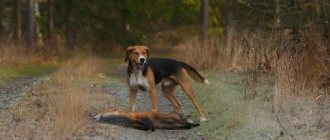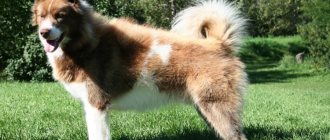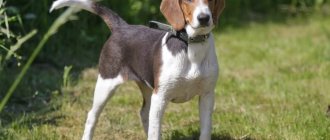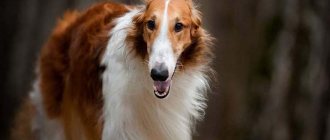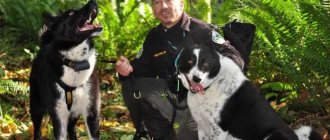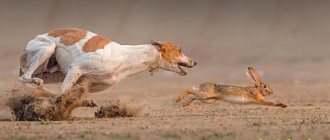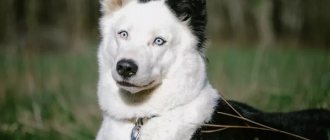Video
* We invite you to watch a video about the Karelo-Finnish Laika . In fact, in front of you is a playlist in which you can select and watch any of 20 videos about a given dog breed by simply clicking on the button in the upper right corner of the window. In addition, the material contains quite a lot of photos. By looking at them you can find out what the Karelo-Finnish Laika looks like.
Rate the material!
[Total votes: 2 Average: 3]
The Karelo-Finnish Laika is an ancient breed of dog that has evolved over centuries. These active animals combine all the qualities necessary for people: they are hunters, watchmen and companions. The dogs were raised not only by people with whom they had spent many centuries side by side, but also by the harsh climate.
Breed characteristics and character traits
The Karelian-Finnish Laika dog breed was bred for hunting, and representatives of the breed cope with this task brilliantly. Resembling foxes in lush winter coats, huskies have extraordinary intelligence, good health, and are able to “wind” dozens of kilometers through the forest.
Working with upland game is their “calling card.” Black grouse, hazel grouse, capercaillie are desirable prey for Karelians. These dogs are happy to chase fur-bearing animals (ferret, squirrel, marten, ermine, etc.)
Huntress
They will find and “mark” with their voice a wild boar, a bear, an elk. But dogs are smart and do not allow direct contact with the animal. Their job is to find the animal and call the owner, and then it’s up to him.
As a rule, they do not like to swim. But some Karelians will gladly climb into a river or stream if they meet them on walks.
History of the origin of Karelian-Finnish huskies
The Karelian-Finnish Laika (aka Finnish Spitz) is a breed of dog from Central Russia, where it lived for several hundred years. The dogs lived in the northern regions among the Finno-Ugric tribes, who developed this breed. Therefore, the Karelian-Finnish Laika fully satisfies the needs of a person living in a communal-tribal system: she is an excellent hunter, a good guard and an excellent companion.
Since Karelian-Finnish huskies lived isolated from the rest of the world, they were not able to interbreed with other dog breeds. This made the breed a kind of aboriginal, since they developed strictly in the same way, crossing only within the breed and focusing only on hunting. Therefore, dogs have remained unchanged for hundreds of years without the opportunity to diversify their genetic potential.
Interesting fact: The arrival of the railroad in 1880 was a decisive moment in the spread of the breed. Tribes were no longer isolated, and dogs, following their people, began to actively crossbreed with dogs of other breeds. Purebred Karelian-Finnish huskies have almost disappeared.
Hugo Roos, a famous Finnish athlete and amateur hunter, became the first person to see breed qualities in the Karelian-Finnish Laika. It was he and his friend Hugo Sunberg who started breeding dogs, looking for purebreds for breeding. They also established the first breed standard, which was announced in the Finnish magazine “Sporten”. Hunters learned about the Karelian-Finnish Laika breed, which is why it quickly gained popularity.
At the same time, the first Finnish Kennel Club was created. The dog breed spreads throughout Europe, but due to World War II, the numbers suffered greatly. By 1979, the Karelian-Finnish Laika was recognized as the national pride of Finland.
Origin story
Representatives of three breeds participated in the creation of the Karelian-Finnish Laika: Olonets (derived from the name of the province), Finnish and Karelian. As a result of crossing, dogs of this breed became small in size, but their appearance was constantly changing. To make the species unchanged, breeders continued the process of inbreeding between the first individuals of this breed and Spitz dogs, which were brought from Finland. Since the results of the crossing were positive, in 1984, thanks to a vote, the two breeds were combined into a single breed - the “Finnish Spitz”.
The Karelo-Finnish Laika especially stands out among hunting
The next stumbling block was the registration of the Karelian-Finnish Laika breed at the international level. The fact is that the presence of the names of two countries in the name is not allowed according to the rules of the International Cynological Federation. Due to the fact that these provisions are unshakable, “Finnish Spitz” was approved as a name. Then this type of dog began to be bred for hunting, as well as for exhibitions. Although she has established herself more as an excellent hunter with good instincts than as a decorative dog.
Advertising:
Karelo-Finnish Laika - description of the breed
The Karelo-Finnish Laika has a bright, memorable exterior. The head has the shape of a triangle with a wide rounded nape and a wedge-shaped muzzle. The forehead is longer than the muzzle, which is shaped by a slightly rounded nose. The brow ridges are well defined, which makes the dog’s gaze expressive.
The lips of the Karelian-Finnish Laika are thin, tightly compressed, and the teeth are completely hidden. The nose is small, black, with a dense nose. The eyes are oval in shape, and the inner corners are slightly slanted towards the bridge of the nose. The eyelids fit tightly to the eyes, which makes the dog resistant to many eye diseases. Eye color can vary from dark brown to beige.
The ears of the Finnish Spitz are erect with dense cartilage. They have the shape of pointed triangles, but are not large and not excessively long, but are proportional to the head. The edges of the ears are sharp, the structure of the ears themselves is elastic and flexible, but not soft.
The torso is square in shape, the paws are slightly longer than necessary in proportion. The dog has a strong and long neck, a straight, well-developed back and high withers. The transition to the croup is smooth, without sharp lines. The legs are strong, set strictly parallel to each other, which makes the dog stable. The joints are tight, the muscles are dry. The rear paws are set slightly wider than the front paws, allowing the dog to push off the ground for wide jumps.
The tail is wrapped towards the back in a roll and is in close contact with the croup. Especially in puppyhood, these dogs resemble foxes. The height of an adult male can reach 50 cm, and an adult female grows up to 47 cm.
Breed standard
The Karelo-Finnish husky in the photo looks like a fox with a dense coat texture. With a weight of up to 13 kg, the height of males is up to half a meter. Bitches weigh up to 10 kg, and the height at the withers is no more than 45 cm.
The animal has a strong, small, pointed head. The skull widens towards the ears, and the muzzle is not too wide. There is a noticeable furrow on the forehead, and the nose has dark pigmentation. The lips are thin and dry, their pigmentation is pronounced. The jaws are strong, the teeth are symmetrical and strong. Scissor bite.
The dog looks at the world with slanted, attentive eyes of brown shades. Ears are held high and erect. They are pointed and constantly in motion. The neck is well developed. Males have a collar. The back is not too long, but powerful, the chest is deep, the tail is usually curved and lies close to the back.
When extended, it reaches the hock joints. The limbs are straight, parallel, the shoulder blades are almost adjacent to each other, and the paws resemble a cat. The pigmentation of the pads is black. Laika has dense, well-fitting skin.
The coat is of medium length and feels dense and rough to the touch. The colors are mostly light – golden-red, fiery red. There may be lighter fur on the chest, face, and ears. White markings on the chest are considered normal.
Popular colors of Karelian-Finnish huskies
Karelian-Finnish huskies are very similar to foxes, especially in puppyhood. In addition to the sharp muzzle, their honey-red coat color makes them similar to these animals.
But even this seemingly simple color has a number of features that must be observed according to the standard:
- The inside of the paws, belly area, and chin should be lighter than the main color of the dog’s body;
- The tail at the very tips and middle of the back should have small dark marks, similar to light tan marks;
- There are small white marks on the chin, abdominal area and chest. They are not mandatory, but are allowed by the breed standard.
If the dog does not meet these requirements, then the individual is subject to culling from the breed - it is not crossed with other dogs in the kennel, but is sold at a reduced price as a pet-class pet. Because of these nuances, you should become thoroughly familiar with the puppy you are about to purchase.
The fur of Karelian-Finnish huskies is also special in its own way. The guard hair is very hard, and the hardest hair is located along the back, on the neck and on the shoulder blades. On the muzzle and at the bottom of the paws the hair is shortest and smoothest. The entire coat lies in a dense layer on the skin, and on the body the guard hair reaches a length of 5 cm. The hair is longer only on the tail and the peculiar “pants” - fluffy hair on the dog’s hind legs - up to 7 cm.
The undercoat of the Karelian-Finnish Laika is soft, thick and dense. Combed wool can be used to knit warm clothes, especially mittens and scarves. The fur on the neck forms a fluffy thick collar, shimmering with gold.
Character and habits of Karelian-Finnish huskies
Karelo-Finnish huskies are active, energetic, cheerful dogs. They are good companions who show loyalty to their owner and the entire family. With their families, these animals are very kind and affectionate, but they show maximum caution, even distrust, towards strangers. Karelian-Finnish huskies are not aggressive, so they get along well with children and play with them with interest.
We must not forget that Karelian-Finnish huskies are, first of all, born hunters, and the hunting qualities in these dogs have been formed over centuries. Therefore, the Finnish Spitz will perceive all small animals exclusively as prey.
Important fact: You should not have birds and hamsters in a house where a Karelian-Finnish husky is kept. Also, while walking, you should keep your dog on a leash so that it does not run after a bird or squirrel. Finnish Spitzes are neutral towards cats and small dogs.
Karelian-Finnish huskies need strict training and good upbringing, which is important to start from early childhood. Socialization is an important part of this dog's maturation. If the animal does not communicate enough with other pets, the dog may grow up to be aggressive, uncontrollable, or overly fearful. Every day it is worth training the Karelian-Finnish Laika, reinforcing the rules of behavior.
Karelo-Finnish Laikas need a firm hand. A permissive attitude towards training can lead to the dog seeing itself as the leader and the family as its pack. Then she may even show aggression towards people, which is unacceptable for any dog.
Character and temperament
Positive qualities of the Karelian-Finnish Laika:
- Devotion to the owner;
- Developed intuition;
- Independent decision making;
- Endurance;
- Performance;
- Strong nervous system.
Negative character traits include:
- Wary of strangers;
- Increased activity.
Working breeds differ from other breeds in their ability to act on their own. They can be stubborn, but with the right approach, problems disappear.
Interesting facts about Karelian-Finnish huskies
Karelo-Finnish dogs are truly brave animals. They are devoid of a sense of fear and can protect their owner from any danger, fearlessly rushing at an opponent and stunning him with a ringing bark. This feature was developed in the dog thanks to the centuries-long development of hunting qualities: even wild boars and bears were hunted with these small huskies. Karelian-Finnish huskies in a flock are able to surround a large animal and keep it in a circle for a long time, barking and lunging until the owner kills the game.
Karelo-Finnish huskies have phenomenal health. These are strong, muscular dogs that do not catch colds and generally tolerate the cold well. Hot weather, on the contrary, negatively affects the well-being of dogs. That is why breeders recommend keeping Karelian-Finnish huskies in outdoor enclosures, letting them home only in cold or hot weather, so that the dogs do not overheat.
The name of the Karelian-Finnish Laika speaks for itself: the dog is tied to two geographical territories at once. The breed was formed for a long time on the territory of Karelia, but it was documented in Finland.
Karelo-Finnish huskies are one of the loudest and noisiest dog breeds existing in the world. This is her most important purpose as a hunter: her loud barking disorients the animals and makes them panic. For this, the dog is valued by hunters.
Championships among dogs of this breed in Finland have their own separate category: King of the Barkers. At the end of the inspection of the dogs, they are allowed to bark to their heart's content to determine the loudest dog. It was at this championship that it was found that the Finnish Spitz can bark up to 160 times per minute.
Pros and cons of Karelian-Finnish Laikas
Like all dog breeds, the Karelian-Finnish Laika has its own advantages and disadvantages that must be taken into account when buying a puppy.
Let's first look at the advantages of this breed:
- Karelo-Finnish huskies have a stable psyche. They are not so easy to piss off. Adult dogs do not give in to fear and do not fall into sudden aggression - the character of an adult Karelian-Finnish husky is unchanged and clearly visible to the owner;
- Karelian-Finnish huskies do not require much care and serious financial costs for maintenance. This is one of the most unpretentious dog breeds in the world. For example, they can be kept in an outdoor enclosure, and this option is even more preferable for this breed;
- Finnish Spitz live long. The average life expectancy is 15 years, but with good care and moderate physical activity they can live up to twenty years;
- Dogs of this breed have many purposes. For example, they can be excellent watchmen, since their loud bark alerts them when strangers approach the protected area. Hunters still use Karelian-Finnish huskies. Also, Karelian-Finnish huskies become companions for people who prefer an active lifestyle.
Now let's look at the disadvantages of this breed:
- This is a stubborn breed of dog. If the dog does not feel the firm hand of the owner, then he will refuse to carry out even familiar commands. These dogs love to get the better of people, so Karelian-Finnish huskies require strict training;
- Finnish Spitz dogs run a lot and generally expend a huge amount of energy, so they love to eat. It is important to properly balance the diet of these active dogs so as not to accidentally harm their body;
- These dogs are very active, so they are not suitable for families who prefer to spend time at home. They need physical activity, long runs and generally walks in nature.
How much does it cost and how to choose a puppy?
The steps involved in purchasing a puppy as a companion dog or as a hunting dog will be slightly different. But not the price. It ranges from 400-500 US dollars, but can be significantly higher - it all depends on the breeder, the puppy’s parents, and its pedigree.
For hunters, it matters how good the hunting qualities the puppy’s parents showed.
Important! The Finnish Spitz is more of a companion dog and a subject for exhibitions.
The Karelo-Finnish husky was originally “sharpened” for hunting; it is a working dog. Therefore, those who want to hunt with a dog should not buy it abroad.
Family
Breeding Karelian-Finnish huskies
A female dog's first heat begins at approximately 14 months of age. This estrus lasts up to 22 days and occurs twice a year. A dog should be bred only after it has gone through three heats. Then the animal’s body is completely ready to bear offspring. During estrus, strict precautions should be taken. The dog will actively search for a male, so all walks must be strictly on a leash.
Even the most obedient dog will try to run away. You cannot leave a bitch in heat alone in an open enclosure, as she will find a way out into the open. In the cold season, the Karelian-Finnish husky, even being resistant to frost, can chill its reproductive system, so it is better to keep it warm. If you intend to get offspring from your dog, then after the third heat, start looking for a suitable kennel where there are purebred males.
As a rule, mating takes place without any particular difficulties. Dogs are willing to make contact, since the pack instinct is clearly developed in them - Karelian-Finnish huskies have always been kept in small groups, and these same groups went hunting with people.
Pregnancy lasts approximately 56-77 days. Early or late birth can lead to the death of the puppies or even the mother herself, so the day of mating should be marked on the calendar and monitor the progress of the pregnancy. In general, Karelian-Finnish huskies are in excellent health, so, as a rule, there are no complications during pregnancy.
The first pregnancy usually brings many puppies: five to six puppies. They should all have a tan-colored coat and set white markings. The more pregnancies a dog experiences, the fewer puppies it will give birth to each time, and the less likely it is to have healthy offspring.
Caring for Karelian-Finnish huskies
Karelo-Finnish huskies are medium-sized dogs, which is why many people decide to keep this breed of dog at home. In fact, keeping these dogs in an apartment is a big mistake. These dogs are very active and mobile, so they require keeping in a spacious enclosure. In addition, the apartment may be too hot for them. The thick undercoat and warm fur allow the dog to feel great even in the cold winter.
It is worth putting an insulated booth in the enclosure, and the space itself should be well protected from the wind so that the dog does not become hypothermic. Usually Karelian-Finnish huskies bask collectively, pressing their bodies against each other. If the dog is alone, then you should take care of how it will keep warm.
Interesting fact: Dogs of this breed need regular exercise. If the animal does not have the opportunity to realize the huge amount of energy that is naturally inherent in these dogs, then it may become depressed. Therefore, long walks and jogs are an important part of caring for your dog.
However, a Karelian-Finnish husky puppy should only be kept at home. A fragile body is susceptible to colds and other diseases. Caring for thick fur is not difficult. Once a week, the dog needs to be brushed with a special brush for fluff, and when shedding, it is better to brush it daily. You need to bathe your dog when it gets dirty, but not more than once every four months.
The dog's eyes, teeth, ears and claws require special care. They should be examined every day so as not to miss a possible disease or inflammatory process. In addition, although the dog has good immunity, it needs to be vaccinated and regularly examined by a veterinarian.
Character
We would like to make a reservation right away that Karelian-Finnish huskies are not dogs for beginners in keeping animals. They are very intelligent, but have a proud and independent, and sometimes stubborn character. Such a dog needs a morally strong, fair and kind owner, to whom he will be devoted until his last breath.
The Karelian-Finnish Laika (reviews from the owners suggest this) should be brought up from a very early age. It is good if this is done by a professional or an experienced animal owner. A well-trained dog obeys its owner unquestioningly, perfectly protects him and his property, and becomes an indispensable assistant on the hunt. But you should know that this proud dog will not forgive anyone for cruel or rude treatment: neither the trainer nor the owner.
Training should be carried out strictly but respectfully. If you are planning to raise a hunting assistant, then Karelian-Finnish Laika puppies are trained from a young age - 5 months. This should be done by experienced hunters. Training necessarily includes both the development of theoretical skills and work in the fields.
Karelian-Finnish huskies easily get along with children, but if your child is too small and cannot understand that this is a living creature, then you should refrain from purchasing such a dog. Let us emphasize once again that representatives of this breed have a complex character - they do not tolerate familiarity in any form, preferring only equal relationships. But for a teenager, the husky will become the best friend and a wonderful partner in noisy and fun games.
Diet of Karelian-Finnish huskies
Finnish Spitz are incredibly voracious, largely due to the fact that they spend a lot of energy every day. They run a lot and love physical activity, so the diet should take into account the active lifestyle of this dog.
When the puppy is one and a half months old, he begins to feed himself. A growing dog should be fed approximately five to six times a day. At three years, the regularity of feeding decreases to four times a day, and at five years - to three. An adult dog eats twice a day, and this is enough to keep the dog well-fed and active.
Important fact: Food should be balanced and fresh. It is highly not recommended to feed the dog from the owner's table: firstly, it erases the boundary between the pet and the owners, which is unacceptable in the case of this breed; secondly, this food may simply be harmful to the dog.
Most of the diet of the Karelian-Finnish Laika should be meat. Choose low-fat foods: chicken, turkey, veal. Dogs readily eat offal, such as liver, kidneys, hearts, lungs, and so on. You should avoid fatty pork and, especially, sausage.
Vegetables must be added to the meat: cabbage, carrots, cucumbers, tomatoes and herbs. This will provide your dog with the required amount of fiber. Some dog owners grind the meat into a single mass in a blender, but breeders do not recommend this. A dog must chew and bite to maintain its teeth. This is why it is also worth giving dogs large, non-tubular bones or special artificial treats that can be chewed.
It is strictly forbidden to feed the Karelian-Finnish Laika the following foods: herbs, pasta, chocolate and all sweets, fried foods, spicy foods, tubular bones (they can get stuck in the throat). Fresh river fish is also excluded from the diet, as it may contain parasites.
Nutrition
The Karelian-Finnish Laika can be fed both natural food and dry commercial food. However, under no circumstances should these two types of nutrition be combined. When a puppy is only one and a half months old, it should be fed very often, at least 5 times a day. As the dog gets older, the number of daily meals can be reduced. An adult dog eats only 2 times a day.
If you want your pet to grow up healthy and happy, you should add various vitamins to the food, or choose foods that are rich in microelements that are important for life.
The following foods should be excluded from the diet:
- any spicy foods, such as red pepper or spices;
- all types of meat in which fat predominates;
- bakery and pasta products;
- chocolate and sugar;
- long bones.
It is highly undesirable to feed your dogs raw fish; you risk infecting your pet with the leaves.
Diseases and health problems
As already mentioned, Karelian-Finnish huskies are characterized by good health and good immunity. Because of this, the list of diseases to which these dogs are susceptible is very small. One of the most common diseases that Finnish Spitz owners face is obesity.
Obesity occurs if the dog lives in an apartment and the owners pay insufficient attention to its physical activity. An active pastime ensures that the dog does not become overweight. Also, the Karelian-Finnish husky can become significantly fat if it does not eat properly and eats a lot of food from the master’s table.
Epilepsy in Karelian-Finnish huskies is rare and is a congenital disease. Typically, puppies with epilepsy rarely survive into adulthood, but if it occurs in a mature dog, you should immediately contact a veterinarian. Such dogs are prescribed treatment and organized a special regime that will not provoke seizures in the animals.
Interesting fact: Sometimes Karelian-Finnish huskies, like other dogs, have allergies. It usually manifests itself when eating specific foods. Then it is worth tracking down what exactly in the dog’s diet causes an allergic reaction and completely eliminating this product from its diet.
Since Karelian-Finnish dogs are very active, it is worth regularly vaccinating them and giving them drugs that get rid of parasites. During a walk, they may eat something from garbage or waste, so infestation with parasites is very likely. You should also treat your huskies for ticks if you walk in parks and forests.
History of the breed
The history of the Karelian-Finnish Laika began in the middle of the 19th century. The dog appeared in Finland when it was still part of the Russian Empire. Therefore, disputes still arise from time to time between Finnish and Russian dog handlers about the “nationality” of this dog.
At first, Finnish experts decided to use this small but very active dog in bird hunting. It even received a corresponding name - bird dog. However, hunting with the Karelian-Finnish husky showed that the dog could not cope with the tasks assigned to it. It was decided to improve the exterior to create an exclusively decorative animal.
Over time, the Russian Empire collapsed. Finland gained independence, becoming a separate state. The countries separated, but the dogs remained on Russian territory. They lived for a long time in Karelia, Leningrad region. Until a certain time, no one paid much attention to them, until at the beginning of the 20th century they became interested in Russian hunters. As it turned out, this small, fast and agile dog shows excellent results in hunting fur-bearing animals. In the middle of the 20th century, Soviet dog handlers became interested in the Karelian-Finnish Laika breed. They began to breed her not only for hunting, but also for participation in exhibitions, as experts noted her outstanding external characteristics.
Nevertheless, in those years she still remained in most cases more of a working dog than a decorative dog. Gradually, the popularity of this cute animal grew, but then the Second World War began, and the population of huskies practically disappeared. Our scientists barely managed to save her.
At the end of the sixties, a large exhibition of hunting dogs was held in the Soviet Union, which included this red-haired beauty. Her first appearance was very impressive. Eyewitnesses recalled that from that time on, her popularity began to grow rapidly. Although it must be said that this concerned only the northern regions of our country. In the south and east of the country, the Karelian-Finnish huskies never spread. Unfortunately, this situation has not changed today. For example, in Rostov-on-Don it is almost impossible to buy such a husky, but in our Northern capital, buying and selling Karelian-Finnish huskies does not cause any problems. Moreover, since the seventies of the 20th century, this breed has been bred in the Leningrad region, and in a factory way.
